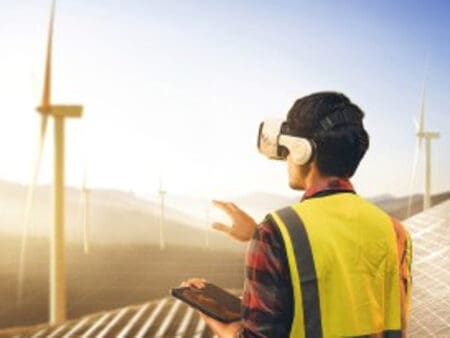
Energy Web looks to become Polkapdot parachain, ChatGPT comes to water utility management and the potential for the metaverse to reduce greenhouse gas emissions and curb global temperature rise are in the week’s technology radar.
Energy Web in Polkadot link up
Energy Web, which has led the development of the blockchain in the energy sector, is looking to Polkadot for its next generation technology.
Polkadot is a platform that unites specialised blockchains or ‘parachains’, such as Energy Web’s, opening up the possibility for interoperability across these and providing the basis for an interoperable decentralised web.
While Energy Web has yet to release full details of its plans – and we’ll report in due course – the organisation has indicated the move will allow it to create the framework for its new Energy Web X as the next generation energy sector blockchain technology.
Have you read?
The metaverse – delivering beyond expectations and here to stay
Secure data share is vital to fast-track renewables says Energy Web boss
A key feature is the implementation of so-called ‘worker nodes’ or decentralised groups of computers that perform work off-chain that can be deployed independently but coordinated in cohesive networks.
Jesse Morris, CEO of Energy Web, anticipates that the shift to Energy Web X will enable partner companies, such as Shell, Vodafone and Volkswagen, to accelerate their decarbonisation strategies.
“To achieve the [clean energy] goal, we decided to search for a blockchain platform that offers real enterprise-grade security and seamless upgradeability to ensure a safe and future-proof environment. Polkadot excels on both of these fronts with its shared security model and best-in-class core technology.”
Energy Web is focused currently on two key areas, one to help electric utilities digitise and integrate distributed energy resources to the grid and the second to bring transparency and verifiability to emerging green product supply chains, including 24/7 matched renewable electricity.
By the end of Q1, a total of 42 parachains had joined Polkadot, representing sectors such as decentralised finance, privacy, social media, sustainability, NFTs, gaming and the metaverse.
By leveraging each other’s strengths to unlock new use cases, parachains help projects expand at scale while enjoying the shared security advantages provided by Polkadot.
ChatGPT comes to utility water management
In what is believed to be a first US headquartered water platform provider Klir has launched generative AI capabilities through the latest iteration of its Klir Comply platform.
Using Microsoft Azure’s OpenAI service to provide access to powerful language models, including ChatGPT-4, water professionals are able to receive insights into their utility’s data through an AI-powered chatbot while benefiting from the scalability, reliability, performance and security of Azure, Klir says.
By blending the conversational benefits of ChatGPT with each utility’s water quality management and compliance data – e.g. “Is our water compliant today?” or “Draft me a summary of last week’s water quality” – the AI function simplifies tedious but critical tasks while ensuring internal data stays secure and private at all times, the company asserts.
In what is stated as a nod of Klir’s Irish roots, the chatbot is represented by ‘Boots’, an Irish Water Spaniel “trained to sniff out key data”.
And ‘Boots’ allows users to query millions of data points within the utility’s private internal data with features including integrating administrative tasks with sampling results data, providing predictive water quality analysis, generating quantitative insights into sampling results and identifying correlations between data.
“Klir’s AI function sits as a layer on top of what is already the most comprehensive software for water quality and compliance management on the market,” declares David Lynch, CEO of Klir.
“To be able to ask complex compliance water management questions and immediately receive accurate answers is seismic and will help organisations around the world to slow the global water crisis.”
Along with introducing the ChatGPT function, Klir also has unveiled a new ‘maturity model’ that assesses and prioritises the key operational risks water utilities face.
Metaverse could reduce greenhouse gas emissions
New research from scientists at Cornell University suggest that the growing metaverse sector could reduce US greenhouse gas emissions by 10Gt CO2e by 2050 and lower the global surface temperature by up to 0.02oC before the end of the century.
The findings emerged from AI-based modelling of data from several key sectors, technology, energy, environment and business, to anticipate the growth of metaverse usage and the impact of its most promising applications including remote work, virtual traveling, distance learning, gaming and non-fungible tokens.
The researchers projected metaverse expansion through 2050 along three different trajectories – slow, nominal and fast – and they looked to previous technologies, such as television, the internet and the iPhone, for insight into how quickly that adoption might occur.
They also factored in the amount of energy that increasing usage would consume.
The modelling suggested that within 30 years, the technology would be adopted by more than 90% of the population, which was more rapidly than expected, and with limiting business travel generating the largest environmental benefit.
“Think about the decarbonisation of our transportation sector,” says Fengqi You, professor in Energy Systems Engineering in Cornell Engineering and senior author of the research.
“Electric vehicles work, but you can’t drive a car to London or Tokyo. Do I really have to fly to Singapore for a conference tomorrow? That will be an interesting decision-making point for some stakeholders to consider as we move forward with these technologies with human–machine interface in a 3D virtual world.”
Currently, two of the biggest industry drivers of metaverse development are Meta (formerly Facebook) and Microsoft, both of which contributed to the Cornell study. Meta has been focusing on individual experiences such as gaming, while Microsoft specialises in business solutions, including remote conferencing and distance learning.
Ultimately however, the metaverse can only do so much, You points out.
“There are so many sectors in this economy. You cannot count on the metaverse to do everything. But it could do a little bit if we leverage it in a reasonable way.”








